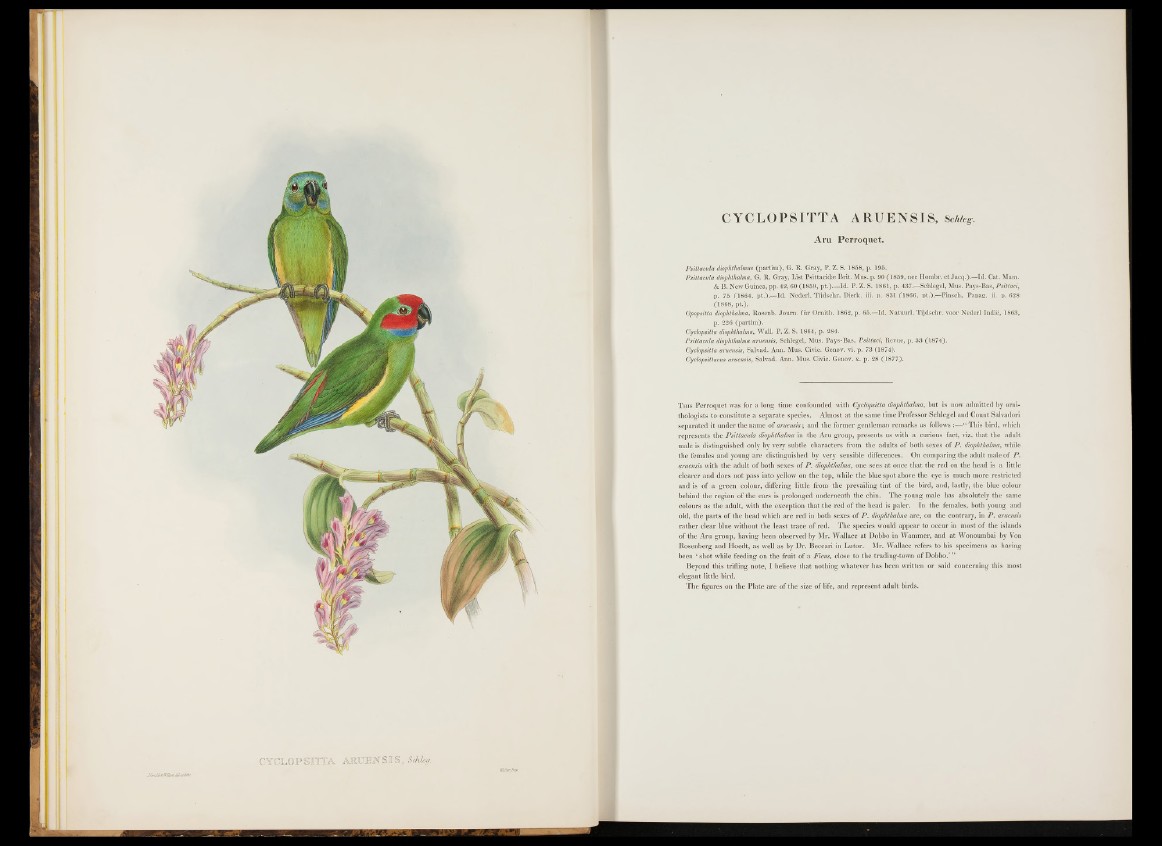
WtùUrJmp
J.(xuU/HlfSBt,ää-d'liäv.
CYCLOPSITTA ARUENSIS, Schleg.
Aru Perroquet.
Psittacula diophthalmus (partim), G. R. Gray, P. Z. S. 1858, p. 195.
Psittacula diophthalma, G. R. Gray, List Psittacidse B rit. Mus. p. 90 (1859, nec Hombr. et Jacq.).—Id. Cat. Mam.
& B. New Guinea, pp. 42,60 (1859, pt.).—Id. P. Z. S. 1861, p. 437.—Schlegel, Mus. Pays-Bas, Psittaci,
p. 75 (1864, pt.).—Id. Nederl. Tijdschr. Dierk. iii. p. 831 (1866, pt.).—Finsch, Papag. ii. p. 628
(1868, pt.).
Opopsitta diophthalma, Rosenb. Joum. für Ornith. 1862, p. 65.—Id. Natuurl. Tijdschr. voor Nederl Indie, 1863,
p. 226 (partim).
Cyclopsitta diophthalma, Wall. P. Z. S. 1864, p. 284.
Psittacula diophthalma aruensis, Schlegel, Mus. Pays-Bas, Psittaci, Revue, p. 33 (1874).
Cyclopsitta aruensis, Salvad. Ann. Mus. Civic. Gènov. vi. p. 73 (1874).
Cyclopsittacus aruensis, Salvad. Ann. Mus. Civic. Genov, x. p. 28 (1877).
T his Perroquet was for a long time confounded with Cyclopsitta diophthalma, but is now admitted by ornithologists
to constitute a separate species. Almost a t the same time Professor Schlegel and Count Salvadori
separated it under the name o f aruensis; and the former gentleman remarks as follows :— “ T his bird, which
represents the Psittacula diophthalma in the Aru group, presents us with a curious fact, viz. th at the adult
male is distinguished only by very subtle characters from the adults o f both sexes o f P . diophthalma, while
the females and young are distinguished by very sensible differences. On comparing the adult male o f P .
aruensis with the adult o f both sexes o f P . diophthalma, one sees a t once th at the red on the head is a little
clearer and does not pass into yellow on the top, while the blue spot above the eye is much more restricted
and is o f a green colour, differing little from the prevailing tint o f the bird, and, lastly, the blue colour
behind the region o f the ears is prolonged underneath the chin. The young male has absolutely the same
colours as the adult, with the exception th at the red o f the head is paler. In the females, both young and
old, the parts of the head which are red in both sexes o f P . diophthalma are, on the contrary, in P . aruensis
rath er clear blue without the least trace o f red. The species would appear to occur in most o f the islands
o f the Aru group, having been observed by Mr. Wallace at Dobbo in Wammer, and a t Wonoumbai by Von
Rosenberg and Hoedt, as well as by Dr. Beccari in Lutor. Mr. Wallace refers to his specimens as having
been ‘ shot while feeding on the fruit of a Ficus, close to the trading-town o f Dobbo.’ ”
Beyond this trifling note, I believe th at nothing whatever has been written o r said concerning this most
elegant little bird.
The figures on the Plate are o f the size o f life, and represent adult birds.